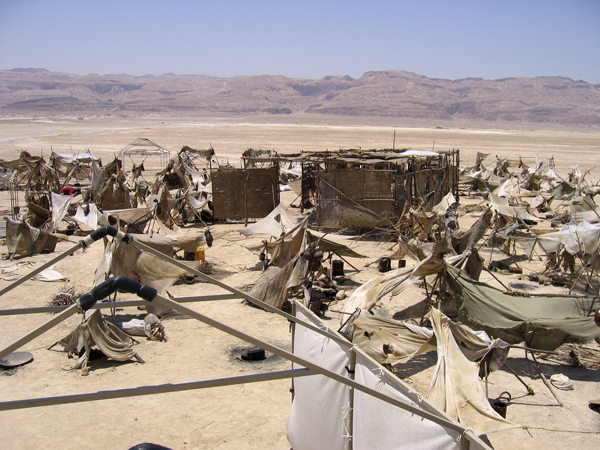Go, See, and Become
I had met Radu several years ago, and I secretly wished to meet up with him again one day on a set. This has happened thanks to Laurent Dailland who knew how to encourage Radu and I want to go further in this adventure. Israel was a great discovery for me, a great lesson in life and I still thank the entire Israeli crew for accompanying me for many weeks with patience and passion.
Given such a topical and emotive subject, I decided to work with an entire crew from Tel Aviv: Rami Simentov as focus-puller; Yehuda Sar Isarael, clapper/loader; Eudi Reimer, gaffer and his team; finally
Radu wanted an epic film and a film that was documentary, lyrical, touching and true. His artistic directions were clear and frank from the start, because he wanted to respect the "Falashas" and their cultural milieu which we were going to describe. And above all, we were going to shoot with numerous Ethiopian Jews who had lived through terrible times in Sudanese camps in 1985, and our discretion was imperative.

Location scouting in January in the Negev desert to reconstitute the camp but also to meet those who would accompany me during the shoot. Shooting in Tel Aviv, Jerusalem and the Negev desert from mid-March to mid-June. I quickly understood that the film would be fairly complex, because it involved shooting black characters dressed in traditional white garb, living in white interiors and in the company of white characters, and all this often in penumbra.
To make things harder, the chosen film format was Super 35 anamorphic, using Radu’s favorite focal lengths between 14 and 18mm. I therefore had moments of great doubt, with scenes that were sometimes insoluble. But all this meant very little in contrast to these incredible moments of emotion, when the Falashas land on the Tel Aviv runway, or again when little Schlomo’s mother forces him to leave her...

Radu gave me a certain freedom with respect to lighting, asking only to keep a healthy negative for blow-up, and to respect the skin tone of the faces and the actor’s gazes. It is therefore not a lighting film but above all a labor of receptivity to locations and characters: seeking to avoid at all costs a photographic dramatization but, on the contrary, to approach the very specific sensation of a documentary without its habitual form. The film is inspired above all by the color of the city and its contrasts: city of color and sun (which had to be present in most scenes), strong morning light and barely golden sunshine, because it was too stark and bright. We ended up in a “location stage” situation during the 3 weeks that we spent in the interior of Roschdy Zem’s apartment, because the schedule repeatedly called for going from day to night on the same shooting day. The other reason being the desire to have sunshine inside the apartment, a very piercing sun, hence numerous Par 12s and 18 k Watts on scaffolding so as to keep a T-stop that would preserve the outside (which was sometimes 7 stops over). The entire set was black-clothed from the roof of the building, and the cloth was lowered for night scenes with no view on the outside (directorial choice). Other big moment of the film: the scenes of the Bar Mitzvah and the wedding with much music and dancing, one of Radu’s specialties.
That’s it. Thanks again to Radu for his trust in me. I want to state that at no moment did I feel ill at ease or in danger, and I greatly appreciated the joie de vivre of the Israelis who for the most part only seek peace; this was probably one of the friendliest shoots I’ve experienced. I thank them.”
Finally I want to thank Didier Dekeyzer and Miguel Bejo from Eclair, Gérard Savary for the beautiful Berlin print, and Edouard Valton and Thomas Coville.
Go, See, and Become (Va, vis et deviens) received the "Grand prix du jury" and the "Prix œcuménique" at Berlin 2005 Film Festival.
(Translated from French by Benjamin Bergery)
Crew
Entire Israeli crew from Tel AvivFocus puller: Rami Simentov
Clapper loader: Yehuda Sar Isarael
Gaffer: Eudi Reimer
Key grip: Guy Naaman
Technical
Camera : Arricam LT Super 35Lenses : Zeiss Ultra Prime
Negative : Kodak 5218 et 5246
Lab : Eclair traditional film chain (Kodak interpositive, Fuji internegative, release prints on new Agfa stock)
Grader : Gérard Savary
Special Effects : Edouard Valton and Thomas Coville
 En
En
 Fr
Fr







